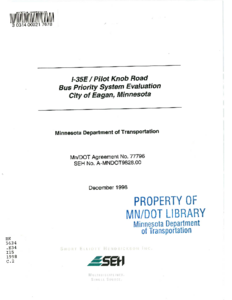I-35E/Pilot Knob Road bus priority system evaluation: City of Eagan, Minnesota
Date Created
1998-12
Description
I-35W Urban Corridor Demonstration Project: Phase 2 Evaluation Report
Date Created
1974-11
Description
I-35W Urban Corridor Demonstration Project: Bus-Metered Freeway System: Final Report
Creator
Date Created
1971-09
Description










